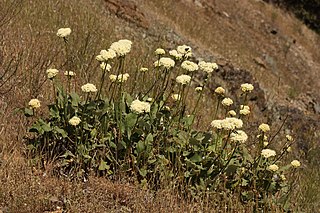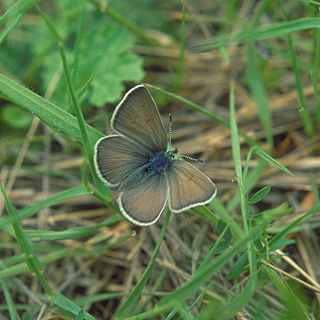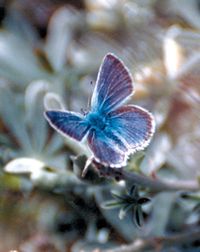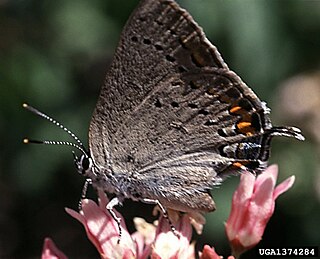
Eriogonum is the scientific name for a genus of flowering plants in the family Polygonaceae. The genus is found in North America and is known as wild buckwheat. This is a highly species-rich genus, and indications are that active speciation is continuing. It includes some common wildflowers such as the California buckwheat.

Apodemia mormo is a principally Nearctic butterfly in the family Riodinidae. It is a particularly fascinating species for ecological and evolutionary research, as evidenced by its shifting taxonomic classifications. Conflicting observations of host plants utilized, distinctive morphologies, and a wide range of occupied habitats have prompted investigation into several potential subspecies. To date, two genetic studies have been done on A. mormo, with analysis revealing that disjunct populations are genetically and phenotypically distinct. These studies support a potential need for refined taxonomies, although a larger body of data is required to make clear decisions.

Eriogonum fasciculatum is a species of wild buckwheat known by the common names California buckwheat and eastern Mojave buckwheat.

Fender's blue butterfly is an endangered subspecies of Boisduval's blue endemic to the Willamette Valley of northwestern Oregon, United States. The potential range of the butterfly extends from south and west of Portland, OR to south of Eugene, OR. The butterfly is host-specific on the Kincaid's lupine, which it relies on for reproduction and growth.

The Mission blue is a blue or lycaenid butterfly subspecies native to the San Francisco Bay Area of the United States. The butterfly has been declared as endangered by the US federal government. It is a subspecies of Boisduval's blue.

Smith's blue butterfly, Euphilotes enoptes smithi, is an subspecies of butterfly in the family Lycaenidae. This federally listed endangered subspecies of Euphilotes enoptes occurs in fragmented populations along the Central Coast of California, primarily associated with sand dune habitat in one case with a dune-based Maritime Coast Range Ponderosa Pine forest in the Carbonera Creek watershed in Santa Cruz County. The range of E. e. smithi is from Monterey Bay south to Punta Gorda.

Icaricia acmon, the Acmon blue, is a North American butterfly. It ranges mainly in California but can be seen north to Oregon and south through Baja California. The tops of the wings are blue with dark edges in males and brown in females. Its underside is white with black spots for both sexes with a red-orange band on the hindwing. Adults feed on nectar while caterpillars can feed on buckwheats, lupines, trefoils, and milkvetches.

Icaricia is a genus of butterflies in the family Lycaenidae. It was first described by the author and lepidopterist Vladimir Nabokov in 1945.

Icaricia icarioides, or Boisduval's blue, is a butterfly of the family Lycaenidae found in North America. This butterfly has 25 recognized subspecies.

Callophrys dumetorum, the coastal green hairstreak, bramble green hairstreak, or bluish green hairstreak, is butterfly of the family Lycaenidae. It is found in the United States in coastal California and rarely in inland California. Subspecies C. d. oregonensis is known as the Oregon green hairstreak.

Callophrys sheridanii, the Sheridan's hairstreak and Sheridan's green hairstreak, is a butterfly in the family Lycaenidae. It is found in North America along the south coast of British Columbia and parts of Nevada, Arizona, Saskatchewan, North Dakota, and New Mexico. In 2009, this species was adopted as the U.S. state butterfly for Wyoming.

Icaricia shasta, the Shasta blue, is a butterfly of the family Lycaenidae. It is found from the northwestern United States to southern Saskatchewan and Alberta.

Icaricia saepiolus, the greenish blue, is a butterfly of the family Lycaenidae. It is found from the northwestern United States to southern Saskatchewan and Alberta.

Satyrium californica, the California hairstreak, is a butterfly of the family Lycaenidae. It is found from British Columbia south to southern California and east to Colorado.

Euphilotes rita, the rita blue or desert buckwheat blue, is a species of butterfly of the family Lycaenidae. It is found in Wyoming, Colorado, Arizona, New Mexico and northern Mexico. The species was first described by William Barnes and James Halliday McDunnough in 1916.

Euphilotes battoides, the square-spotted blue or buckwheat blue, is a species of butterfly of the family Lycaenidae. It is found in western North America from Washington south to Baja California Norte and then west to southern Colorado and New Mexico.

Euphilotes pallescens, the pale blue, pallid blue or pallid dotted blue, is a species of butterfly of the family Lycaenidae. It is found in the United States in southeastern California, Nevada, southern Utah and northern Arizona.

Callophrys affinis, the western green hairstreak or immaculate green hairstreak, is a butterfly of the family Lycaenidae. It is found in western Canada and the western United States.

















